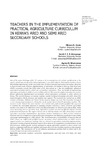TEACHERS IN THE IMPLEMENTATION OF PRACTICAL AGRICULTURE CURRICULUM IN KENYA’S ARID AND SEMI ARID SECONDARY SCHOOLS

View/
Date
2018-08Author
Kyule, Miriam N.
Konyango, Jacob J. J. O.
Nkurumwa, Agnes O.
Metadata
Show full item recordAbstract
One of the major challenges of the 21
st
century is the increasing level of academic qualifications at the
expense of relevance in education. School agriculture is one of the subjects which require teachers who as
the principal implementers of the curriculum must be able to interpret agriculture curriculum objectives
to meet societal needs. However, implementation of agriculture curriculum in Arid and Semi Arid Land
(ASAL) secondary schools has fallen short of its expectations as it has not significantly influenced
agricultural activities both in school and surrounding communities. Thus, the benefit of implementing
agriculture curriculum in ASALs is yet to be fully achieved. The research sought to document the teacher
factors influencing implementation of secondary school agriculture curriculum in ASAL schools in
Kenya. The research focused on teacher training, teacher technical knowledge and skills about Dry
Land Agriculture [DLA] practices and training and support. The research was carried out in ASAL
counties of Baringo, Makueni and Narok. Survey research design was used. The researcher developed
a semi-structured questionnaire to obtain data on the teacher factors from 88 agriculture teachers. The
research results showed that most teachers were trained and professionally qualified thus expected
to translate the curriculum objectives to learning activities relevant to ASALS. However, agriculture
teachers were found to be deficient in terms of technical knowhow on DLA practices among them, insitu
water harvesting and use of sunken beds. Agriculture teachers received insufficient support towards
professional development. The support did not aim at DLA knowledge and skill enhancement towards
agriculture curriculum implementation. Agriculture teachers’ inadequacy on DLA practices’ technical
knowhow and lack of support towards professional development was impacting negatively on agriculture
curriculum implementation in ASAL schools. The Government has a responsibility of ensuring that all
ASAL schools are staffed with qualified teacher. Secondary school administrations in ASALs need to
support teachers on continuous trainings that are relevant to agriculture curriculum implementation.
Agriculture training program developers need to focus more on the acquisition of technical know on all
DLA practices. Addressing the training inadequacies among agriculture teachers in ASAL schools will
lead to a competent staff who can translate curriculum objectives into learning experiences that promote
DLA in ASALs. This translation will in turn influence agricultural activities both in school and in the
society for improved agricultural production.
